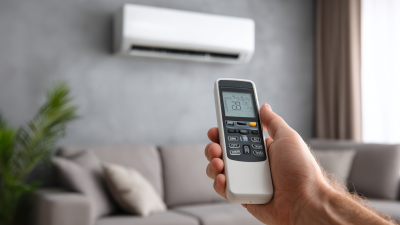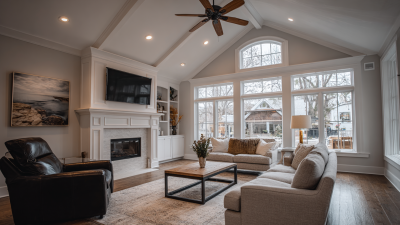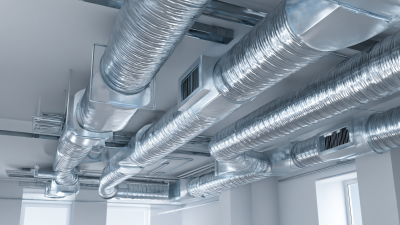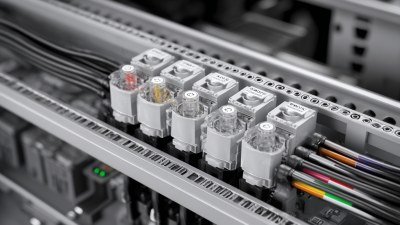Essential Guide to Home Air Conditioning Installation: Tips for Choosing the Right System for Your Space
When considering home air conditioning installation, it's crucial to make informed decisions to ensure comfort and efficiency in your living space. According to the U.S. Department of Energy, air conditioning can account for up to 12% of the total energy expenses for a typical household, emphasizing the need for selecting an appropriate system. The market for air conditioning is projected to grow significantly, with a report from Mordor Intelligence predicting a CAGR of 5.5% from 2021 to 2026, driven by rising temperatures and increasing demand for energy-efficient solutions.

Therefore, understanding the various types of systems available, their efficiency ratings, and the specific needs of your home can save money in the long run and enhance your household's overall comfort. This essential guide will equip you with the necessary tips and knowledge to choose the right air conditioning system for your space, ensuring a cool and pleasant environment during the hottest months.
Understanding Different Types of Air Conditioning Systems for Home Use
When considering air conditioning systems for home use, it’s essential to understand the different types available on the market. The most common systems include central air conditioning, ductless mini-split systems, window units, and portable air conditioners. According to the U.S. Department of Energy, central air systems are often the most efficient for larger homes, providing uniform cooling throughout the space. These systems can be costly to install, but they typically last longer and offer better energy efficiency, with SEER (Seasonal Energy Efficiency Ratio) ratings often exceeding 15.
On the other hand, ductless mini-split systems have gained popularity due to their flexibility and efficiency. A report from the American Society of Heating, Refrigerating and Air-Conditioning Engineers (ASHRAE) indicates that these systems can achieve SEER ratings of 25 or higher, making them a compelling choice for homeowners looking to reduce energy consumption. Window units and portable air conditioners, while less efficient, are often more budget-friendly solutions for cooling individual rooms, especially in smaller spaces. Each of these systems has its advantages, and choosing the right one depends on factors like home size, layout, and personal cooling preferences.
Evaluating Energy Efficiency Ratings: SEER and EER Explained
When choosing an air conditioning system, understanding energy efficiency ratings is crucial for making an informed decision. The Seasonal Energy Efficiency Ratio (SEER) and the Energy Efficiency Ratio (EER) are two key metrics to consider. SEER measures the cooling output during a typical cooling season divided by the total energy consumed in watt-hours. This rating is particularly valuable for regions with significant variations in temperature across seasons, as it provides a holistic view of energy efficiency over time. A higher SEER rating indicates that the unit is more efficient, potentially leading to lower utility bills and a reduced environmental impact.
On the other hand, EER measures the cooling output at a specific operating condition. Unlike SEER, which considers seasonal changes, EER is determined at a standard temperature (usually 95°F outdoors) and reflects the unit's performance during peak demand periods. For those living in hotter climates where air conditioning use is consistent, EER becomes an essential factor in selecting the right system. By evaluating both SEER and EER ratings, homeowners can better assess the efficiency of potential air conditioning units, ensuring they choose a system that not only meets their cooling needs but also aligns with energy-saving goals.
Assessing Your Space: Calculating BTUs for Optimal Cooling
When considering air conditioning installation, accurately assessing your space is crucial for choosing the right system. One of the key metrics to focus on is the British Thermal Unit (BTU), which measures the cooling capacity of an air conditioning unit. The optimal BTU rating depends on several factors, including the size of the room, ceiling height, insulation quality, and the number of windows. For instance, a room of 300-400 square feet typically requires an air conditioner with a BTU rating between 8,000 and 10,000. Failing to select the right BTU can lead to inadequate cooling or unnecessary energy consumption.
Moreover, recent reports indicate that top-performing air conditioners vary greatly in efficiency and effectiveness across different models. Tests have shown that the highest-rated window air conditioners can cool spaces quickly while maintaining low energy consumption and minimal noise levels. By understanding the specific requirements of your room and matching them with the right BTU capacity, you'll ensure optimal performance and comfort during the hot summer months, making your investment in an air conditioning system worthwhile.
Best Practices for Installation: Common Mistakes to Avoid
When installing an air conditioning system, avoiding common mistakes is crucial to ensure efficiency and longevity. One of the most significant errors is selecting a system that does not match the size of the home. According to the Department of Energy, an improperly sized unit can lead to increased energy consumption and inadequate climate control. For instance, an oversized unit will cool a space too quickly, preventing it from dehumidifying effectively, while an undersized unit struggles to maintain comfort levels, resulting in higher electricity bills.
The installation process itself is another area where mistakes frequently occur. A report by the Air Conditioning Contractors of America highlights that improper sealing of ducts can cause air leaks that significantly decrease system efficiency—by up to 30%. Additionally, neglecting to properly level the outdoor unit can lead to compressor issues over time. Employing best practices, such as ensuring proper insulation and maintaining recommended refrigerant levels, can not only prevent these pitfalls but also enhance the system's overall performance and lifespan. Prioritizing these considerations during the selection and installation phases guarantees a comfortable living environment while maximizing energy efficiency.
Essential Guide to Home Air Conditioning Installation: Tips for Choosing the Right System for Your Space - Best Practices for Installation: Common Mistakes to Avoid
| Dimension | Details |
|---|---|
| System Type | Central Air Conditioning |
| Ideal Room Size | Up to 2,000 sq. ft. |
| Energy Efficiency Rating | SEER Minimum: 14 |
| Installation Time | 1-3 Days |
| Common Mistake | Incorrect Sizing of Unit |
| Maintenance Tip | Change Filters Regularly |
| Cost Estimate | $3,000 - $7,000 |
| Warranty Duration | 10 Years |
Regular Maintenance Tips to Extend the Life of Your Air Conditioning System
Regular maintenance is crucial for extending the life of your air conditioning system and ensuring it operates at peak efficiency. One of the simplest yet most effective tips is to change or clean the air filters regularly. Clogged filters can restrict airflow, making the system work harder and potentially leading to costly repairs. Aim to check your filters every month, especially during peak usage seasons, and replace them as needed.
Another important aspect of maintenance is scheduling annual professional inspections. A qualified technician can perform a comprehensive check-up, addressing any potential issues before they escalate. During these inspections, make sure to have the coolant levels checked and ensure that the ducts are clean and free of obstructions. This not only helps in maintaining the system but also improves the overall air quality in your home.
Additionally, consider investing in a programmable thermostat. This allows you to optimize your cooling system based on your daily routine, reducing unnecessary wear and tear. By setting your thermostat to higher temperatures when you’re away from home, you can ease the load on your air conditioning system while still keeping your space comfortable when you return.
Related Posts
-

2023 Guide to Air Conditioning Systems: Understanding SEER Ratings and Energy Efficiency for Your Home
-

How to Choose the Right Residential Air Conditioning Installation for Your Home Comfort Needs
-

Ultimate Guide to Efficient Air Conditioning Installation for Your Home Comfort
-

Understanding the Importance of Proper Air Conditioning Duct Installation for Energy Efficiency
-

Exploring the Advantages of AC Trunking for Modern Electrical Systems
-

The Ultimate Guide to Choosing the Right Residential Air Conditioning System for Your Home